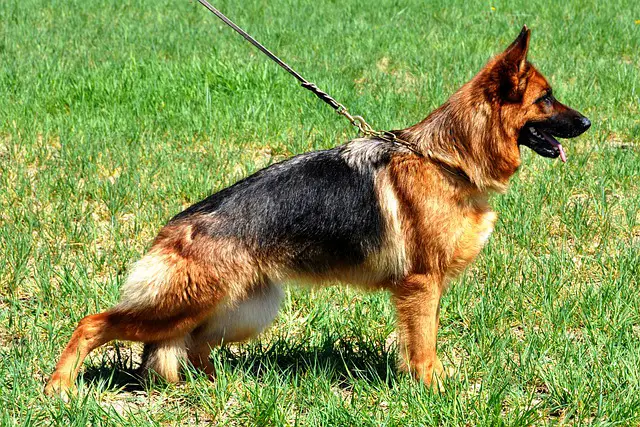The guide below might be a good complimentary guide to this guide on how to train a German Shepherd, including top tips, and advice from a professional dog trainer.
You’ll want to know where to start with dog commands, what the basic commands are, and what some advanced commands are if they suit your situation.
We’ve put together both the essential and advanced commands for German Shepherds, that should be good for both around the house and in public.
Let’s get to them!
(NOTE: this is a general information guide only, and is not professional advice, or a substitute for professional advice. A qualified vet or animal expert is the only person qualified to give you expert advice in regards to your pet/s)
List Of Basic and Advanced Dog Commands For German Shepherds
German Shepherd Training Equipment & A Few Tips
Before you jump into teaching your dog commands, there are a few things you should be aware of first:
Training is usually categorised into on leash and off leash training
There is puppy training which is usually the basic commands, and there is advanced training which is usually for dogs 2 years or older who have much better attention spans as they are matured physically and mentally and considered adults at this point
Basic equipment for training might include a collar, leash, harness, training food reward treats, training toy reward, and sometimes a clicker
In addition to focusing on training, you might like to focus on socialising and building a bond with your dog
Basic Commands For Your German Shepherd
These are the commands every dog should know. Not only are they good to control your dog, but they can also make life safer for your dog and those around them
Sit: The dog sits in one place with his/her attention on you until given another command.
Come/Here: Your dog comes to you and stays with you until given another command. The alternative to this is that when you say your dog’s name – they immediately pay attention/come to you. Some professional trainers argue this command is the most important thing you can teach your dog because of how valuable it can be out in public.
Drop: Your dog drops whatever item they are holding in their mouth. Good for dog toys, puppies and dogs around children and babies.
Leave It: Your dog moves their focus away from whatever item you don’t want them to focus on or pick up. Good for when out walking or around the house.
Stay: Can be used in combination with sit and come. Stay is great if you are doing something and you’ll be right back, but your dog can’t follow you for some reason.
Down: Especially good for young or hyperactive German Shepherds. Down is used to stop a German Shepherd jumping on people.
Advanced Commands For Your German Shepherd
Advanced commands can be advanced in terms of difficulty, or could just be advanced in terms of the fact that a dog doesn’t necessarily need to know the commands if they already know the basic ones.
Stop: your German Shepherd will stop what it is doing. Good for dogs that try to eat their poop, bite at their lead, jump on people, chew things etc.
Back up: if an owner senses a situation where the dog is getting agitated, ‘back up’ will make the dog back away from the situation until it either goes away or so that dog and owner can leave.
Bark: Usually an owner doesn’t want a dog to bark too much. But this command can be good for situations where you might need to make noise or alert someone about something.
Shake: The dog offers their paw and shakes hands.
Steady: Can use this commands in situations where you know your dog might get triggered by things which excite them or distract them. Steady is a command that indicates to your dog they should stay close by you and remain even tempered.
Stand: The dog stands still without reacting or moving. Good for if you want to wash, brush or applying flea treatment to your dog without them mouthing you or walking away.
Bed: Good for puppies, dogs who seek attention, and in general for when it’s late at night – indicated to your dog to go to bed and go to sleep.
Give: Instead of drop, you can ask your dog to ‘give’ a dog toy or another item they have picked up to you by releasing their grip on the item and letting your grasp it.
Roll Over: Usually the command that comes after drop. The dog rolls over and presents their stomach to you.
Attack: Used most often with protection or security K-9’s. Dogs are taught to attack threats to themselves and their owners with this commands.
Fetch: Good one for the dog park or the backyard. The dog can fetch a ball or dog toy or bone you have thrown for them.
Heel: the dog stays by your side while walking. A good one for dogs who like to pull on their leash. Read more about German Shepherd heeling training here
Friendly Disclaimer
TheDailyShep.com are not veterinarians, or animal professionals/experts. Information provided is for informational purposes only – it is not a substitute for professional or qualified advice.
The information is based on either our own thorough research, and/or own experiences, as a means of free speech.
By consuming this information, you accept that TheDailyShep.com do not have client or patient relationship with you, and TheDailyShep.com are not advising you to act on anything you read.
You should always consult your own veterinarian, animal expert, or health care professional and follow their advice before making decisions on all matters.
You can find our full set of disclaimers and T & C’s in the footer of this site.
Enjoy your reading, and thank you for being here
','' ); } ?>